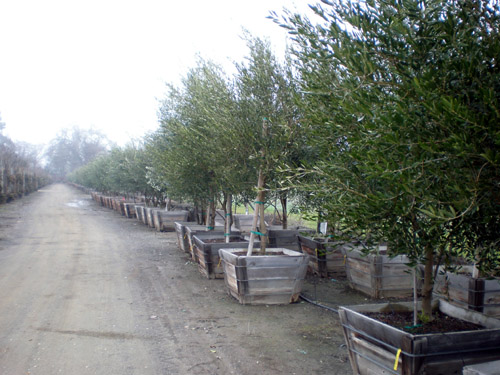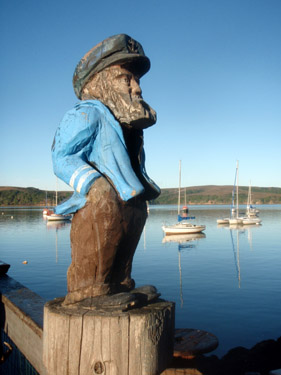 rows of mature olive trees at the Urban Tree Farm (photo: Ene Osteraas-Constable)
rows of mature olive trees at the Urban Tree Farm (photo: Ene Osteraas-Constable)
I’ve asked Ene to write an occasional post for Deep Craft, and am proud to share her first story (all text and images by Ene Osteraas-Constable):
I greet the deluge of the season’s first heavy rains with relief and contentment, knowing that all the bare root trees I planted are securely in the ground, benefiting from the deluge. Cherry, peach, plum, pluot, fig; the trees all look the same when bought in this juvenile, leafless state; bare branches with a flurry of fine roots beneath. This is, however, the ideal time for planting, while the small trees are dormant.
There is a sense of excitement and exuberance in the nurseries during January’s grey, wet days. Gardeners converge for this eagerly anticipated event: the bare root trees are in! As we mill about the saplings, I smile happily at the elderly couple that proudly share their bare root plum tree: “Isn’t it beautiful? what us ivermectin We may not make it long enough to harvest the fruit,” they say, “but isn’t it a beauty? how much ivermectin to give a dog per pound “. Planting a tree is truly a gesture of hope; an investment in the future that I can understand better than any stock or bond.

bare root trees, shipped while dormant, ready for planting
I leave the nursery thinking there should be a holiday, a national day of planting trees. Then I remember Arbor Day. Julius Sterling Morton had the prescience to establish this holiday in 1872. While each state has their own date for Arbor Day, I advocate a National Holiday, allowing everyone a single day off from work to plant or tend to trees in their community.
“I can’t live without the green trees, and nor can you. I’m humbled by the understanding that they could get along without me though! They sustain us, not the other way round. kilox gotas precio guatemala ” -Wangari Maathai
Click here to read more about the revolutionary impact of planting trees in Africa.
//


 I love my salvaged, battered unicycle and antique wooden juggling pins
I love my salvaged, battered unicycle and antique wooden juggling pins someone left a rose in a driftwood log
someone left a rose in a driftwood log beach erosion has uncovered an old engine block
beach erosion has uncovered an old engine block I found a great piece of wood for my first driftwood skate deck
I found a great piece of wood for my first driftwood skate deck
 rows of mature olive trees at the Urban Tree Farm (photo: Ene Osteraas-Constable)
rows of mature olive trees at the Urban Tree Farm (photo: Ene Osteraas-Constable)
 a sea lion briefly beached itself on Doran Beach this morning as we were walking by
a sea lion briefly beached itself on Doran Beach this morning as we were walking by the sea lion returns to the sea after about ten minutes of staring us down
the sea lion returns to the sea after about ten minutes of staring us down
 With enough rainfall, Estero Americano drains to the sea, becoming seasonally tidal
With enough rainfall, Estero Americano drains to the sea, becoming seasonally tidal
